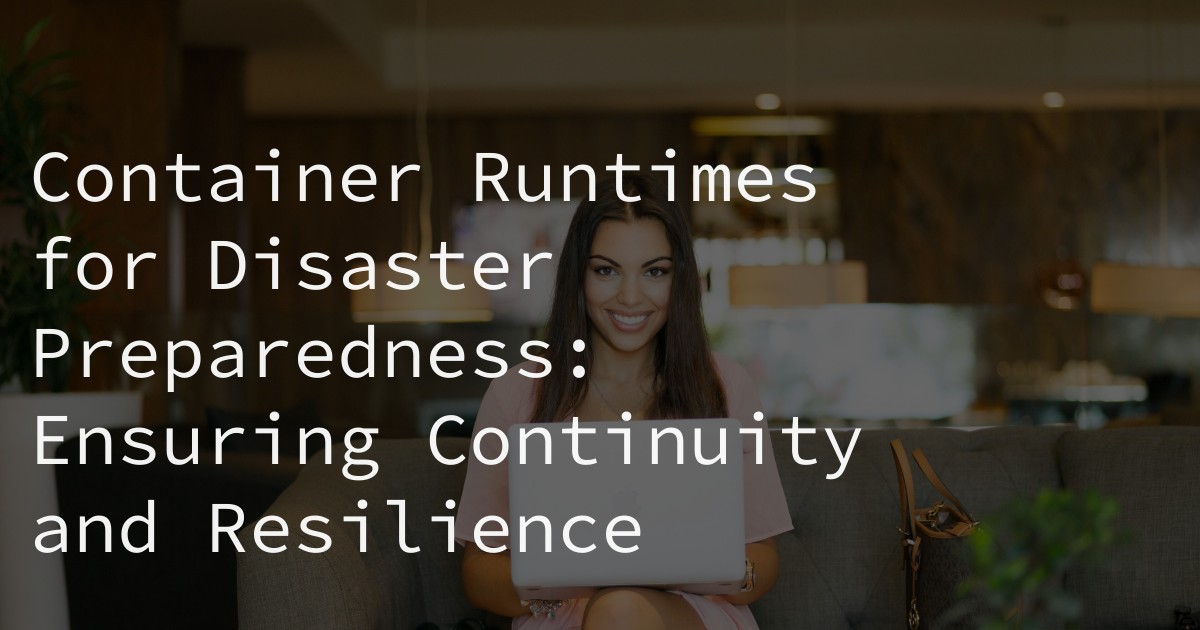
05 Nov Container Runtimes for Disaster Preparedness: Ensuring Continuity and Resilience
Container runtimes play a crucial role in cloud computing and cloud-native computing. These tools allow for the efficient deployment and management of applications in a virtualized environment. In today’s ever-evolving technological landscape, disaster preparedness and resilience have become essential for businesses to ensure continuity and minimize downtime. In this article, we will explore the various ways in which container runtimes can be utilized for disaster preparedness and recovery, along with other essential tools and strategies to build resilient systems.
Kubernetes and Docker: Essential Tools for Disaster Preparedness
Kubernetes and Docker are two of the most widely used container runtimes in the industry. Kubernetes is an open-source platform for automating the deployment, scaling, and management of containerized applications, while Docker is a popular tool for creating, deploying, and running applications in containers. These tools are essential for disaster preparedness as they provide the following advantages:
- Efficient resource utilization: Kubernetes and Docker allow for the efficient use of resources, making it easier to scale up or down in case of a disaster.
- High availability: These tools enable the deployment of applications across multiple nodes, ensuring high availability in case of a disaster.
- Easy migration: With Kubernetes and Docker, applications can be easily migrated to different environments, making it easier to recover from a disaster.
To make the most out of Kubernetes and Docker for disaster preparedness, it is essential to follow best practices such as regularly backing up data, using rolling updates, and implementing disaster recovery strategies.
Linux and Cloud Native Computing Principles for Disaster Resilience
Linux is the most widely used operating system in cloud computing and plays a crucial role in cloud-native computing. Its open-source nature and flexibility make it an ideal choice for building resilient systems. Additionally, cloud-native computing principles, such as microservices architecture, containerization, and automation, are essential for disaster resilience. These principles allow for the quick recovery of applications and minimize downtime in case of a disaster. By utilizing Linux and cloud-native computing principles, businesses can build resilient systems that can withstand any disaster.
CI/CD Pipelines and Infrastructure as Code for Continuity Strategies
Continuous integration and continuous delivery (CI/CD) pipelines are crucial for ensuring the smooth deployment and delivery of applications. In case of a disaster, these pipelines can be used to quickly deploy applications to a backup environment, minimizing downtime. Additionally, infrastructure as code (IaC) allows for the automation of infrastructure deployment, making it easier to recover from a disaster. By incorporating CI/CD pipelines and IaC into disaster recovery strategies, businesses can ensure continuity and minimize the impact of a disaster.
Monitoring, Logging, and Tracing for Disaster Recovery
Monitoring, logging, and tracing are essential components of any cloud computing environment. In case of a disaster, these tools play a crucial role in identifying and resolving issues, ensuring a quick recovery. By regularly monitoring and logging system activity, businesses can quickly identify any issues and take necessary actions. Tracing allows for the tracking of requests and identifying any bottlenecks in the system. By implementing these tools, businesses can minimize the impact of a disaster and ensure a smooth recovery process.
Networking and Storage/Data Management for Resilient Systems
In disaster scenarios, networking and storage play a crucial role in ensuring the availability of applications and data. By utilizing smart networking and storage strategies, businesses can build resilient systems that can withstand any disaster. This includes implementing redundant network connections, utilizing distributed storage, and regularly backing up data. By incorporating these strategies, businesses can minimize the impact of a disaster and ensure continuity.
Service Mesh and Security for Disaster Preparedness
Service mesh is a popular tool for managing and securing microservices in a cloud-native environment. Its role in disaster preparedness is crucial as it allows for the quick deployment of applications and services in case of a disaster. Additionally, security is a critical aspect of disaster preparedness and resilience. By implementing security best practices, businesses can ensure the protection of their applications and data in case of a disaster. By utilizing service mesh and implementing robust security measures, businesses can ensure continuity and minimize the impact of a disaster.
DevOps, DevSecOps, and FinOps for Continuous Improvement
DevOps, DevSecOps, and FinOps are methodologies that promote collaboration, automation, and continuous improvement in software development and operations. These methodologies are essential for disaster preparedness and resilience as they allow for the quick identification and resolution of issues. By incorporating these methodologies into disaster recovery processes, businesses can ensure continuous improvement and minimize the impact of a disaster.
Conclusion
In today’s technological landscape, disaster preparedness and resilience have become crucial for businesses to ensure continuity and minimize downtime. Container runtimes, such as Kubernetes and Docker, along with other essential tools and strategies, play a crucial role in building resilient systems. By utilizing these tools and following best practices, businesses can minimize the impact of a disaster and ensure continuity in their operations.
RELATED ARTICLES:



Sorry, the comment form is closed at this time.